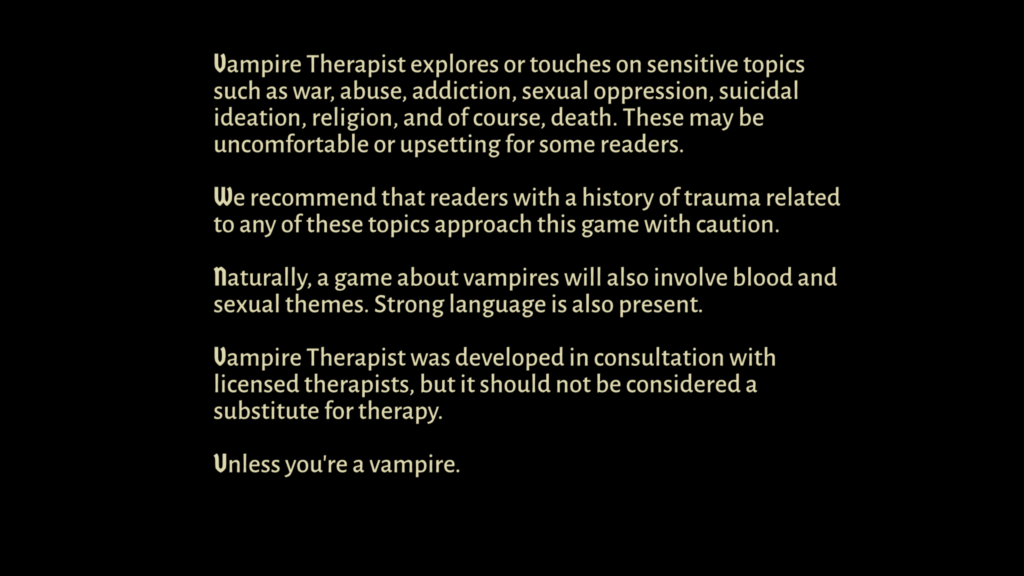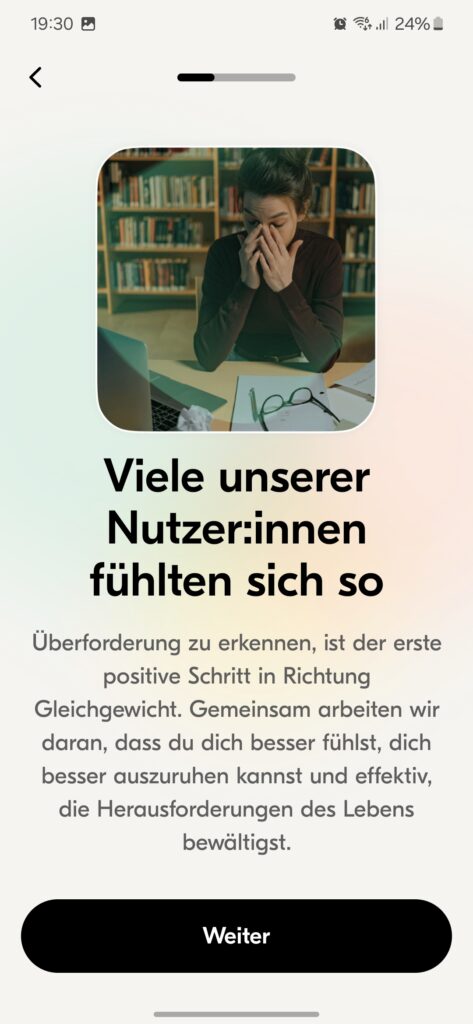Introduction
When I was thinking about what activity I could do for my last blog post, I considered serious games and how they might approach the topic of therapy. So, I logged onto Steam, one of the biggest video game platforms, and searched for the term therapy. To my surprise, not many games came up, and most were of questionable quality. However, I stumbled upon a game called Vampire Therapist by Little Bat Games—a game where you play as a cowboy vampire acting as a therapist for other vampires. The premise sounded absurd, but with a 96% positive review score, my curiosity was piqued. So, I decided to try the free Steam demo.

My Experience with the Game
The game describes itself as a visual novel dark comedy. As the player, you act primarily as a listener, making choices from predefined text options. The game can be roughly split into two parts: the story and the therapy sessions—though, of course, they are closely intertwined. During the story sections, you mostly listen as the narrative unfolds. In the therapy sections, however, you have to actively engage, listening carefully to what the characters say and then identifying the psychological concepts at play. This can get pretty tricky and forces the player to really think about and understand the concepts being presented.
The player takes on the role of a cowboy vampire who listens to the struggles of other supernatural beings—werewolves dealing with anger issues, ghosts struggling to move on, and other creatures wrestling with their personal demons (both literal and figurative). In the demo, you meet an older vampire who serves as both a mentor and therapist—someone who helps you on your journey to aid others. The first patient you encounter is a failed scientist (or at least he believes himself to be one) who became addicted to his own chemicals. What I found particularly interesting is how the protagonist, despite being the helper, also requires guidance to challenge his own preconceptions and grow.
The visuals are moody and certainly fit the theme. I wish to point out the voice acting which, at least major characters, has been very good so far.

What makes Vampire Therapist stand out is how it blends fantasy with real-world mental health concepts. While the characters may be supernatural, their struggles feel deeply human—self-doubt, trauma, anxiety, and the need for self-acceptance. Instead of just telling players about these issues, the game allows them to engage with them firsthand. It also approaches these heavy topics with a lot of charm, clever metaphors, and humor, creating a safe space to explore difficult emotions in a more approachable way.
The game takes a bit of time to get going, but over the course of my playthrough, it introduced essential elements of Cognitive Behavioral Therapy (CBT). Specifically, it focuses on cognitive distortions—false or irrational ways of thinking that negatively impact our perception of ourselves and the world. One example is „Polarized Thinking“, or as the game cleverly calls it, „Nosferatu Thinking“—the tendency to see things in black and white, without acknowledging complexity. Other cognitive distortions explored in the game include:
- Should Statements – imposing unrealistic expectations on oneself or others.
- Control Fallacy – believing we have total control over everything or no control at all.
- Labeling – defining oneself or others in an overly simplistic, often negative way.
- Disqualifying the Positive – downplaying or ignoring positive experiences.
The game introduces these concepts gradually, giving players enough time to absorb and reflect on them. For me, this playful, interactive approach was surprisingly effective—I found myself quickly internalizing these ideas.
Conclusion
Going into this, I wasn’t expecting much—especially with a premise this absurd. And, to be fair, parts of it are absurd and comedic. But beneath the humor, I found something much deeper: a thoughtful exploration of CBT techniques and a game that genuinely tries to teach the player something meaningful.
Vampire Therapist is more than just a quirky indie game—it’s a clever and engaging look at mental health, self-acceptance, and the importance of compassionate listening. And I’m glad I got to experience it.
Links
https://store.steampowered.com/app/2481020/Vampire_Therapist
https://www.thegamer.com/vampire-therapist-review
https://vampiretherapist.com
https://www.therapistaid.com/worksheets/cognitive-distortions
https://en.wikipedia.org/wiki/Cognitive_distortion#:~:text=A cognitive distortion is a,to being exaggerated or irrational.








